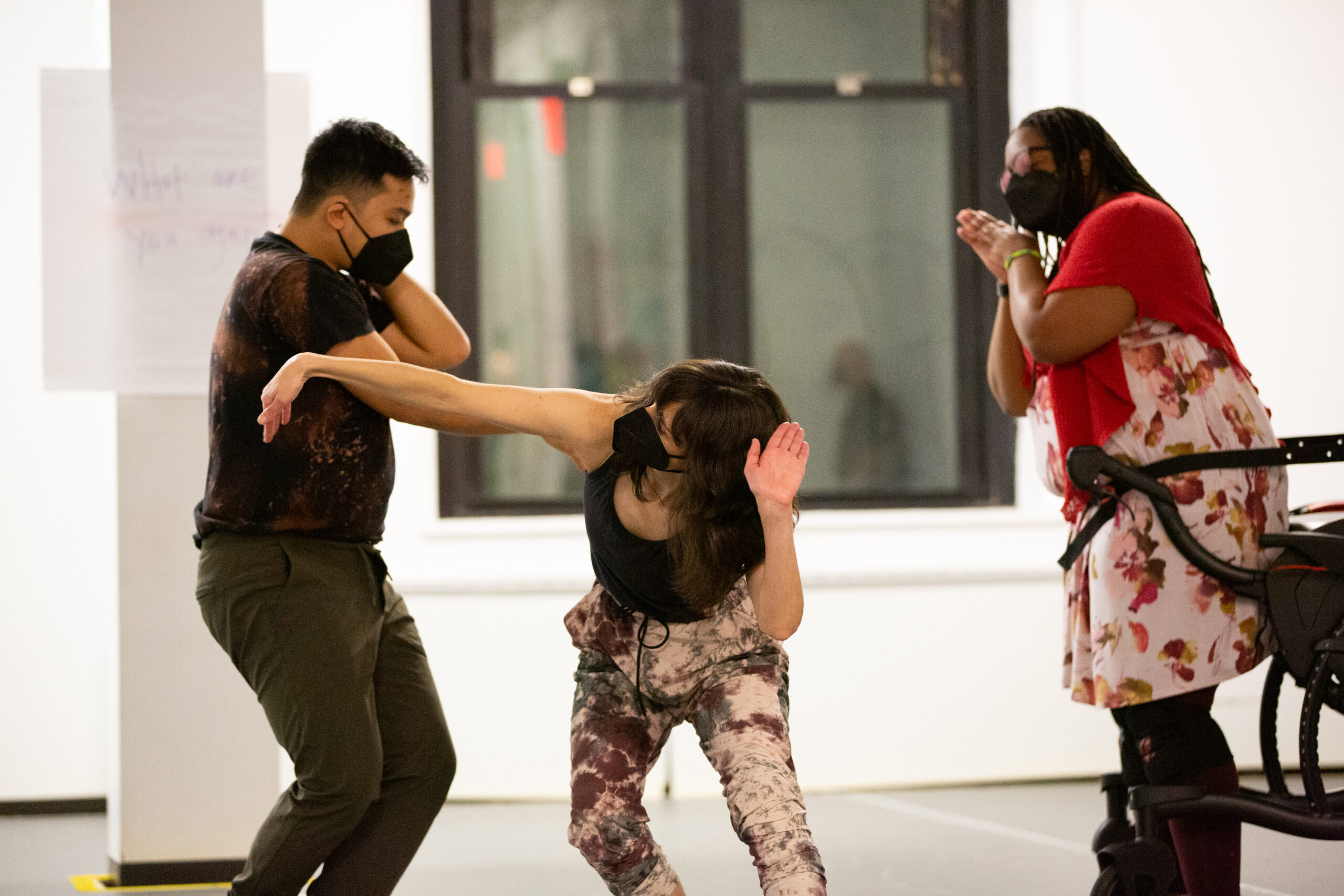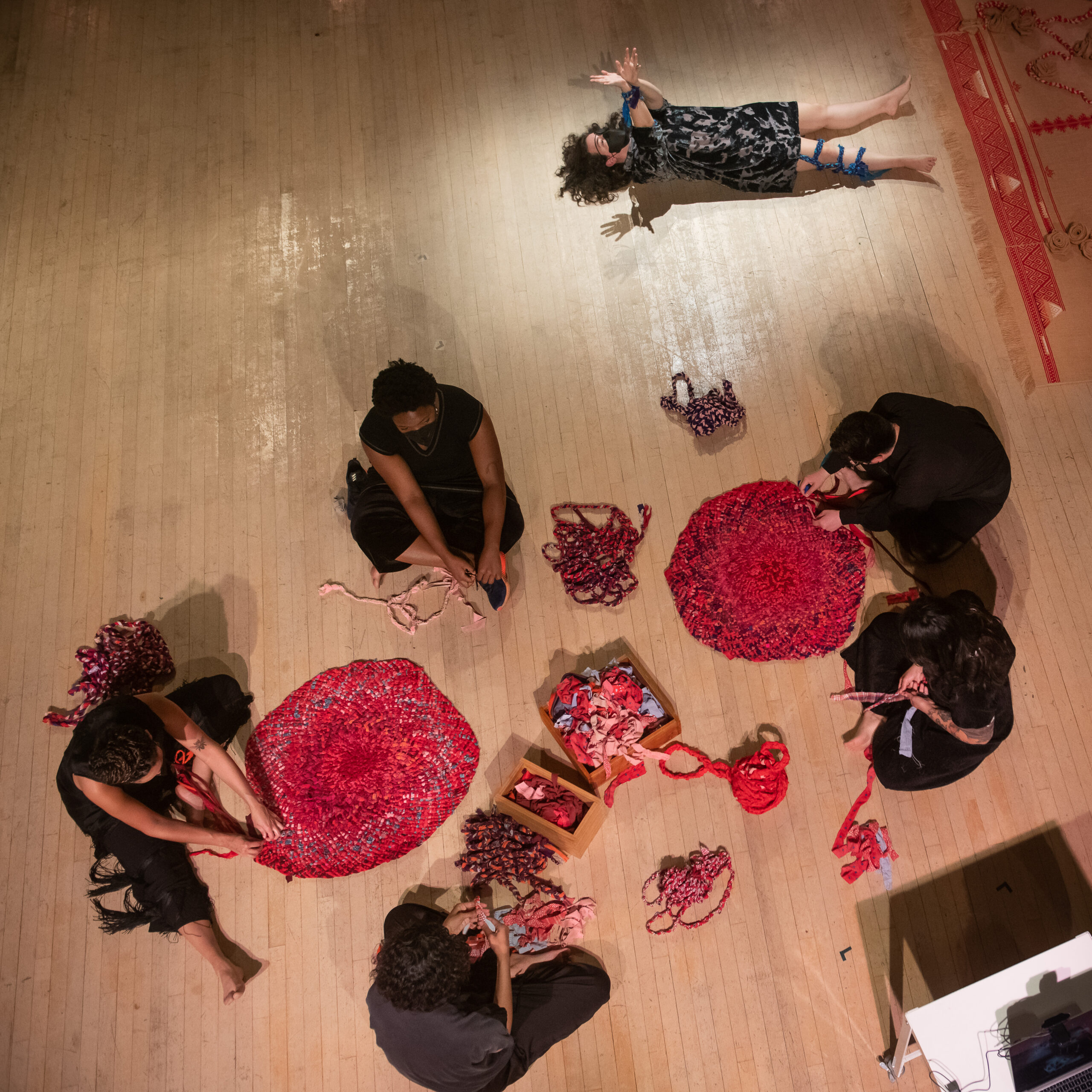Audio Recording
Co-Creating Disability Dance
Disability dance is ever-growing in the dance field as more and more D/disabled artists understand choreography to be a valuable site for exploring the lived experience of the disabled body. Disability dance is beneficial not only for the ways in which it counters and makes visible the social and political marginalization of the disabled body but also for the ways it disturbs conventional understandings of disability and amplifies the D/disabled dancer as a site of embodied ideology. Despite the expansion of disability dance, there remains a dearth of in-person gatherings, accessible performance, critical discourse, venues, and rehearsal spaces for D/disabled, chronically ill, blind, low vision, vision impaired, Sick, D/deaf, hard of hearing, neurodivergent, and Mad dancers. Indeed, many D/disabled dancers and dance makers are asking questions about what needs to be in place in order to work with other D/disabled dancers in cross-disability practices. The term ‘cross-disability’—proposed by the Disability Justice-based performance collective Sins Invalid—refers to an exchange process between people with varying disability experiences and identities. Cross-disability work aims to remove barriers between groups of D/disabled people and spur on notions of interdependence, an integral principle of the Disability Justice Movement. Cross-disability work aims to remove barriers between groups of D/disabled people and spur on notions of interdependence, an integral principle of the Disability Justice Movement. Sins Invalid describe cross-disability processes to work “with and through the complexities and messiness that inevitably arise in this coming together.” An event titled ‘ASSEMBLE: Co-Creating Disability Dance’, designed for Disabled dancers and dance makers in the US, was one such integral opportunity.
On a chilly day in New York in January 2025, thirteen multi-disabled dance artists arrived at Brooklyn Arts Exchange’s new accessible space (BAX Annex) to participate in a day-long convening. The gathering was supported with funding from Jacob’s Pillow and BAX. As organizer of the event, I invited some of the key stakeholders in the US disability dance community to come together—to assemble—through accessibility, care, shared practices, and discussion. Contributing dance artists arriving from Georgia, Los Angeles, New York, and San Francisco, included Nadia Adame, Kiera Bono, Vanessa Hernández Cruz, Anna Gichan, Jerron Herman, Laurel Lawson, Michelle Mantione, Elisabeth Motley (myself), iele paloumpis, Perel, Alice Sheppard, Leslie Taub, and Larissa Velez-Jackson. Also joining were staff, arts workers, and administrators from Jacob’s Pillow and BAX who participated in the day as witnesses and listeners in hopes of better growing their practices for supporting disability dance.
As steward of the event, I proposed ASSEMBLE as an opportunity to discuss how we, as Disabled dance artists, might shape the future of the field on our own terms. I imagined a day of shared-ness and being together (something which, due to cost and labor intensities, is often challenging to accomplish), where we might honor the artistic and creative labor Disabled dancers and dance makers are already doing. The event was also an opportunity to reflect deeply on the value of cooperation over competition and wonder about the futures made possible through co-creating disability community and disability dance. My initial planning for the particulars of the event occurred while connected to tendrils of medical wires and monitors and from a hospital bed—an experience far too familiar to many D/disabled, chronically ill, and Sick artists who, like me, understand their artwork and community to be deeply entwined with their lived experiences of disability. As I moved through an intense recurrence of autoimmune encephalitis, a brain disease that impacts my neuro-physical ability, I imagined ASSEMBLE as a day when we all might experience care and hold critical discussions on the politics of disability dance labor. At the time, my dynamic lived experience of disability, while seemingly in conflict with my role as facilitator, instead bolstered my commitment to disability kinship.


From the very start of the day, with BAX’s doors swinging wide open and access workers welcoming participants, to socializing, sharing a meal, and making closing statements, accessibility was central to ASSEMBLE. ‘Access’ as a tool and practice allowed for our coming together. Participants filled out access surveys before the event, stating their access needs and desires. Specific information about the venue, including architectural accessibility details, was provided to participants, as was accessible travel information. Participants received a fee and travel stipend. The convening included ASL, real-time captioning, snacks, drinks, a range of seating options, a quiet room, and an Access Kit, which consisted of a standard first aid kit, electrolytes, scent-free pain relief ointment, ACE bandages, fidget or stimming toys, blankets, a heating pad, cold packs, noise-canceling headphones, and a cooler to store medication and food. As a community, and before our gathering, we took time to consider a set of community agreements that would serve our collective work and the kinds of discussions and art practices we wished to engage with.
ASSEMBLE commenced with Disabled dance and interdisciplinary artists Perel and Larissa Velez-Jackson acknowledging the momentous occasion, including the rarity of our collective presence. Perel honored the considerable effort that the participants made in arriving at BAX, that D/disabled people in general make, in arriving and navigating the uncertainties of our inaccessible and disabling landscapes. Through hopeful meditations, they asked participants to travel time and summon future disabled artworks at BAX Annex. Following this, Larissa Velez-Jackson guided us through a tactile meditation with gestures that flowed into participants introducing themselves. Each of us audio described ourselves and arrived in the space with Velez-Jackson’s prompt to “give of ourselves as well as receive.”


Practice sharing continued with iele paloumpis, who invited participants to engage with the multi-dimensional nature of their art making, an interdisciplinary practice that “interweaves movement with voice and textiles.” As a group, we explored paloumpis’s rich method of collaborative rug weaving. This practice highlights sensorial and touch-based understandings and joins with paloumpis’s lineage with Greek and Anatolian ancestors. Paloumpis shared with us how their multidisciplinary work emerged out of necessity—experiences of visual impairment and chronic pain—which called for the invention and braiding of multiple modes of practice. During paloumpis’s workshop, vibrant red, purple, and blue circular rugs were splayed across the studio floor in various stages of completion. Many disabled hands learned the mechanics of weaving, touching, and reaching across fabric tears. Bodies and fabric tangled together, sharing weight, and testing the boundaries of how to move while connected. While weaving and moving, we knotted our bodyminds together, hoping for a strengthened disability dance community and a proliferating disability dance lineage.




Next, Vanessa Hernández Cruz, a Disabled experimental dance artist whose work explores the intersections of digital art, technology, and film, facilitated what she calls ‘Cyber Realms.’ Cruz describes Cyber Realms as “a movement workshop designed to facilitate movement generation, [and] choreographic ideas” through the imagination. Participants are welcome to follow the desires of their bodies and move (or not move) as they wish. Cruz guided our movements with various prompts and invitations that supported “dream world[s] coming alive.” As we all danced and moved together, yet differently through our subjective disabled realities, Cruz reminded us of our interconnectedness in the dance studio and in the universe. She drew our attention to the collection of energies in the space, noting that energy and effort can “come in all forms, and all are received with grace from the universe.” Dancing together, supported by audio description, floor cushions, mats, blankets, and celestial whooshing sounds, we explored how to move, both as individual and collective constellations in time.
The wide range of disability dance, including contemporary, experimental, integrated, and inclusive dance, means that D/disabled dance artists don’t necessarily share the same artistic values. The agenda generated by the participants of ASSEMBLE yielded no shortage of desired discussion points, including tackling issues of how to fold even more D/disabled dancers into our existing networks, and strategies for creating regular iterations of in-person gatherings. Participants noted the “siloed representations of artists with intellectual/developmental/learning disabilities in disability dance spaces” (Leslie Taub) and longed for a robust diversification of our stages. We also asked questions about how to honor our divergent aesthetic interests in dance making. The wide range of disability dance, including contemporary, experimental, integrated, and inclusive dance, means that D/disabled dance artists don’t necessarily share the same artistic values. While we ran out of time during our discussions, many of us hoped for future critical discussions about our differences. Some wondered about what we do share, and how this might allow us to better support one another through and because of our differences.
Finally, several participants emphasized a desire for resource sharing amongst D/disabled dancers, especially in a contemporary dance ecology of scarcity and a production market that often pits artists against one another. The convening made it abundantly clear that D/disabled dance artists require specific career support that non-disabled dancers do not require. For example, traditional networking and production-oriented artmaking is not always accessible to D/disabled dancers. Furthermore, the cost of accessibility is necessary and often out of reach for artists and organizations alike. Voicing a passionate and urgent call for space, time, and funding, ASSEMBLE participants applauded Laurel Lawson’s statement that, “Accessibility does cost. And it deserves the cost to pay our interpreters fairly, to pay our captioners, and other kinds of access providers. Access does… and deserves… to cost.”
Access does... and deserves... to cost.
In an essay about dance company Urban Bush Women in The Community Performance Reader, performing arts director, writer, and scholar Anita Gonzalez examines questions about the sometimes precarious nature of being in relational practices with others. Gonzalez writes on how communities are created, performed, and maintained, and sounds a note of caution about assuming that a group of people with a shared experience might have common perspectives.
ASSEMBLE reaffirmed that disability is best supported by celebrating the co-existence of our differences.Indeed, the very nature of togetherness is antithetical to the disabled experience, as the disability culture’s lineage of non-belonging looms large over what is often felt as a false sense of inclusion. In other words, through our non-normativity and our variegated edges of disabled knowing, our movements, embodiments, and dances might be better understood through their discord rather than their concord. The utopian ideal of coming together does not always align with the contingency of disabled experience. ASSEMBLE reaffirmed that disability is best supported by celebrating the co-existence of our differences. Amidst a dance ecosystem that intensely values notions of traditional productivity and competition, the increased development of gatherings, processes, and approaches that honor the collision of access needs in cross-disability spaces is paramount. Ultimately, ASSEMBLE pushed beyond the challenges and discomfort of coming together to ask, what are the dances of D/disabled bodyminds as they reach toward other D/disabled bodyminds, and what kinds of processes ensure rigorous dance access, care, and community? As D/disabled dance artists, we remain ready and fervent to come together and share in disabled care and rage.
Additional Resources
Inside the Pillow Lab: Larissa Velez-Jackson
10 Principles of Disability Justice